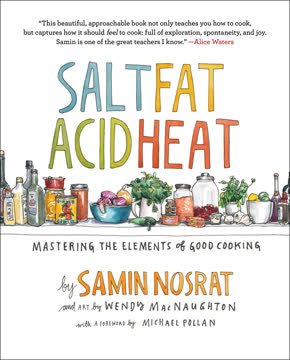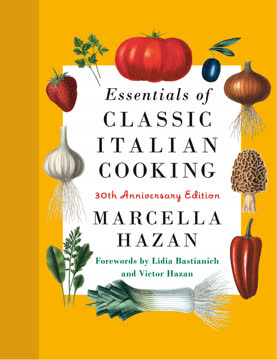Key Takeaways
1. Italian Cooking is a Tapestry of Distinct Regional Cuisines
The cooking of Italy is really the cooking of regions that long antedate the Italian nation, regions that until 1861 were part of sovereign and usually hostile states, sharing few cultural traditions and no common spoken language—it was not until after World War II that Italian began to be the everyday language of a substantial part of the population—and practicing entirely distinct styles of cooking.
Regional diversity. Italian cuisine is not a monolithic entity but a vibrant mosaic of distinct regional traditions, each shaped by centuries of independent history, geography, and local produce. These regional differences are so profound that a dish from Venice would be unrecognizable in Naples, despite both being coastal cities with rich seafood histories. The culinary landscape shifts dramatically even between close neighbors like Bologna and Florence.
Geographic influences. Italy's unique geography, with its boot-like peninsula, towering Alps, and spine-like Apennines, creates diverse climatic zones that dictate local ingredients and cooking fats.
- Northern Plains (Veneto, Lombardy, Piedmont): Dairy zone, butter is the primary cooking fat, staples include rice for risotto and cornmeal for polenta.
- Central Italy (Tuscany, Umbria, Latium): Olive oil replaces butter, and factory-made hard-wheat pasta becomes more prevalent than homemade egg pasta.
- Emilia-Romagna (Bologna): Known as Italy's richest gastronomic region, producing wheat for handmade pasta, Parmigiano-Reggiano cheese, and fine pork products.
Unique identities. Each region boasts a culinary identity as distinct as its dialect. Bologna's cuisine is exuberant and rich, featuring dishes like veal stuffed with Parma ham and truffles. Florence, in contrast, offers austere harmonies, exemplified by a simply grilled T-bone steak with olive oil and pepper. Understanding this regionality is key to appreciating the true breadth of Italian cooking.
2. The Soul of Italian Food Resides in the Home Kitchen
It is in all of those places, because it is everywhere. It is not the created, not to speak of “creative,” cooking of restaurant chefs. It is the cooking that spans remembered history, that has evolved during the whole course of transmitted skills and intuitions in homes throughout the Italian peninsula and the islands, in its hamlets, on its farms, in its great cities. It is cooking from the home kitchen.
Cucina di casa. The true essence of Italian cooking, regardless of region or social class, is found in the home kitchen – la cucina di casa. This tradition emphasizes inherited skills, intuition, and a deep cultural memory, rather than the fleeting trends of "creative" restaurant cuisine. It's a pattern of cooking that welcomes improvisation while remaining recognizable and comforting.
Timeless principles. Italian home cooking is characterized by timeless principles that prioritize taste and familiarity over novelty. Dishes evolve subtly over generations, always striving for simpler, clearer expressions of primary flavors and often reducing reliance on cooking fats. This continuous refinement ensures that each dish remains a comforting and recognizable part of the civilized life.
Universal accessibility. Essentials of Classic Italian Cooking is designed as a kitchen handbook for cooks of all levels, from beginners to accomplished chefs. It aims to provide an accessible and comprehensive guide to the products, techniques, and dishes that constitute this enduring tradition of home-style Italian cooking, making authentic flavors achievable for everyone.
3. Master the Foundational Techniques of Flavor Building
FLAVOR, IN ITALIAN DISHES, builds up from the bottom. It is not a cover, it is a base.
Architectural flavor. Italian cooking emphasizes building flavor from a solid foundation, rather than merely adding it on top. This architectural principle is central to most Italian dishes, from pasta sauces and risottos to soups and stews. Mastering three key techniques—battuto, soffritto, and insaporire—is crucial for achieving authentic Italian taste.
The three pillars:
- Battuto: A finely chopped mixture of ingredients, traditionally lard, parsley, and onion (now often olive oil or butter, with garlic, celery, or carrot). It forms the raw base for countless dishes. Pesto is a classic battuto a crudo (raw battuto).
- Soffritto: A battuto that has been gently sautéed until the onion is translucent and garlic (if used) is pale gold. This step precedes the addition of main ingredients and is critical; an imperfect soffritto will compromise the entire dish's flavor.
- Insaporire: "Bestowing taste," this is the step where main ingredients (like vegetables or meat) are added to the soffritto and briskly sautéed over lively heat. This ensures they are thoroughly coated and infused with the foundational flavors, preventing a "feeble" or "lame" taste.
Careful execution. The success of these techniques hinges on careful execution. Onions must be translucent, not stewed; garlic must be pale gold, never dark or bitter. This meticulous attention to the initial stages ensures that the primary flavors of the dish are vibrant and well-integrated.
4. Uncompromising Quality and Selection of Ingredients are Paramount
The taste they have been devised to achieve wants not to astonish, but to reassure. It issues from the cultural memory, the enduring world of generations of Italian cooks, each generation setting a place at table where the next one will feel at ease and at home.
Ingredient integrity. The true taste of Italian cooking relies heavily on the quality and freshness of its ingredients. Marcella Hazan emphasizes that the goal is not to astonish with novelty, but to reassure with familiar, well-integrated flavors. This means selecting the best possible produce, meats, cheeses, and oils, as their inherent qualities form the backbone of the dish.
Key ingredient insights:
- Anchovies: Choose meaty, salt-packed anchovies for rich, round flavor; avoid harsh pastes. Always chop fine and dissolve gently in warm, not hot, oil.
- Balsamic Vinegar: True Aceto Balsamico Tradizionale di Modena is aged for decades, dark brown, dense, and balanced. Use sparingly, as a few drops enhance, but overuse can cloy.
- Basil: Use only fresh, raw basil for its seductive fragrance. Tear, don't cut, leaves. Never use dried or powdered.
- Parmigiano-Reggiano: The undisputed "Parmesan," protected by law, aged 18+ months. Buy in wedges, grate fresh, and pair with butter-based sauces.
- Extra Virgin Olive Oil: The only grade a careful cook should use. Its flavor is critical for both salads and cooking; choose based on regional characteristics (e.g., Ligurian is shy, Tuscan is fruity/spicy). Store properly to prevent rancidity.
- Tomatoes: Ripeness on the vine is essential. If fresh, ripe plum tomatoes are unavailable, use canned imported Italian plum tomatoes. Avoid watery, tasteless varieties.
Mindful sourcing. The author's detailed guidance on selecting and preparing ingredients like capers, fontina, garlic, mortadella, porcini, prosciutto, and radicchio underscores the philosophy that the dish is only as good as its components. This meticulous approach ensures that every element contributes harmoniously to the final, comforting taste.
5. Pasta: A Deliberate Art of Matching Type to Sauce
One pasta is not better than the other, they are simply different; different in the way they are made, in their texture and consistency, in the shapes to which they lend themselves, in the sauces with which they are most compatible. They are seldom interchangeable, but in terms of absolute quality, they are fully equal.
Pasta's dual nature. Italian pasta falls into two main categories: factory-made, dried macaroni (semolina and water) and homemade, fresh egg pasta (eggs and soft-wheat flour). Neither is inherently superior; they are simply different, each suited to specific sauces and culinary applications. Understanding these distinctions is crucial for achieving harmonious flavor and texture.
Factory-made pasta:
- Composition: Semolina (hard wheat) and water.
- Characteristics: Rough surface, compact body, maintains firmness, chewy.
- Best with: Olive oil-based sauces, seafood sauces, light vegetable sauces.
- Shape matters:
- Spaghettini: Ideal for olive oil-based seafood sauces.
- Bucatini/Perciatelli: Good with thicker, butter-based tomato sauces.
- Rigatoni/Penne/Conchiglie/Fusilli: Best for chunky meat or vegetable sauces, or dense, creamy sauces that cling to twists and hollows.
Homemade fresh pasta:
- Composition: Eggs and soft-wheat flour (sometimes spinach for green pasta). No salt, olive oil, or water.
- Characteristics: Delicate consistency, light, buoyant, highly absorbent.
- Best with: Subtly constituted sauces, often butter-based and enriched with cream or milk.
- Examples:
- Tagliatelle: Classic with Bolognese meat sauce.
- Fettuccine/Tonnarelli: Excellent with butter and Parmesan, or cream sauces.
- Tortellini/Tortelloni: Best with delicate cream or butter sauces, or in broth.
Al dente perfection. Regardless of type, pasta must be cooked al dente—firm to the bite. This ensures buoyancy and allows the pasta to briskly deliver the flavors of its sauce. Proper draining and immediate, thorough tossing with the sauce are also non-negotiable steps for a successful pasta dish.
6. Risotto: A Patient Dance of Rice, Broth, and Constant Stirring
It is only through the gradual administration of small quantities of liquid, through its simultaneous absorption and evaporation, and through constant stirring, that the rice’s soft starch is transformed into a clinging agent, pulling the grains together and fastening on them the taste of the flavor base.
The risotto technique. Risotto is a unique Italian dish that leverages the amylopectin (soft starch) in specific rice varieties. The cooking method is precise: raw rice is lightly toasted in a flavor base, then small quantities of simmering liquid are gradually added and stirred constantly until absorbed. This process dissolves the starch, creating a creamy texture that binds the rice to the flavor base.
Key elements for perfect risotto:
- Rice varieties: Only imported Italian varieties like Arborio (plump, sticky), Vialone Nano (stubby, firm), or Carnaroli (most excellent, balanced) are suitable.
- Flavor base: Can be almost anything edible—cheese, fish, meat, vegetables. It usually starts with onion sautéed in butter (or olive oil), with main ingredients added before the rice.
- Cooking liquid: Fine, mild meat broth for most risottos; water for seafood risottos. Avoid strong stocks that can overpower the delicate flavors. Retain liquids from ingredients like mushrooms or blanched vegetables.
- Constant stirring: Essential for starch dissolution and creamy binding.
- Gradual liquid addition: Allows for simultaneous absorption and evaporation, concentrating flavors.
- Al dente consistency: Rice should be tender but firm to the bite, never mushy or chalky.
Regional styles. Risotto has two main styles:
- Compact (Piedmont, Lombardy, Emilia-Romagna): Denser, stickier, compatible with substantial bases like cheese, sausage, or wild mushrooms.
- All'onda (Veneto): Looser, "wavy" consistency, delicate with seafood and spring vegetables.
Serving. Risotto benefits from resting a minute or so on the plate before eating, allowing flavors to meld and steam to dissipate.
7. Frittate: The Versatile, Open-Faced Omelet for Any Occasion
A frittata may be described as an open-faced Italian omelet. Like an omelet, it consists of eggs cooked in butter with a variety of fillings. But the texture, appearance, and cooking procedure of a frittata are quite unlike those of other types of omelets.
Distinctive character. Unlike its French counterpart, the Italian frittata is an open-faced omelet, firm and set (but never dry), round like its pan, with ingredients mixed directly into the raw eggs. It's cooked slowly over low heat, often finished under a broiler to set the top, resulting in a single, thin, flavorful layer.
Basic method for success:
- Egg preparation: Beat eggs until yolks and whites are evenly blended, then thoroughly mix in chosen fillings (vegetables, cheese, meat).
- Slow cooking: Melt butter in a non-stick skillet over medium heat, pour in the egg mixture, and reduce heat to very low. Cook until the eggs set and thicken, with only the surface remaining runny.
- Finishing: Briefly run the skillet under a broiler to set the top, preventing browning. Alternatively, flip it or bake it entirely in the oven.
Versatile serving. Frittate are incredibly versatile, tasting equally good hot, warm, or at room temperature. They are ideal for:
- Appetizers: Cut into wedges for an antipasto platter.
- Light meals: A satisfying main course.
- Sandwiches: A delicious filling.
- Picnics and buffets: Travel beautifully and add variety.
Flavor foundations. Frittate can be built on various flavor bases, from simple cheese or onions to more complex combinations like zucchini and basil, or even leftover pasta. The slow cooking ensures that the flavors meld beautifully, creating a comforting and satisfying dish.
8. Polenta: A Humble Staple Transformed by Time and Tradition
For a quarter of a millennium, in the Veneto and Friuli, as well as in much of Lombardy, it was polenta, more than any other food, that sustained life. Preparing it was a ritual, eating it was like receiving a sacrament.
Historical staple. Polenta, a cornmeal mush, was once the lifeblood of Northern Italy, particularly in the Veneto and Friuli regions. Its preparation was a cherished ritual, transforming humble cornmeal into a deeply satisfying meal. The traditional method involves slow, continuous stirring in an unlined copper kettle (paiolo) for 40-45 minutes, resulting in a golden, creamy mass.
The traditional method:
- Ingredients: Water, salt, coarse-grained Italian yellow cornmeal.
- Process: Add cornmeal in a thin stream to boiling salted water, stirring constantly with a whisk, then a long wooden spoon, for 40-45 minutes until it pulls cleanly from the pot.
- Consistency: Thick and firm enough to quiver when moved, never thin or runny.
- Serving: Poured steaming onto a circular board, often with a scooped-out center for sauces.
Versatile applications: Polenta's versatility extends beyond a simple side dish:
- Soft & hot: Served with butter and Parmesan, creamy gorgonzola, steamed seafood, or as a bed for stews, braised meats, or roasted fowl.
- Cooled & firm: Sliced, grilled, and served with mixed fried seafood; baked in layers like lasagna with various fillings; or cut into sticks, fried crisp, and served with salads or aperitifs.
No-stirring and instant options. While continuous stirring yields the best results, a no-stirring method (with intermittent stirring) can produce good polenta. Instant polenta offers convenience but sacrifices some texture and fragrance, making it better suited for dishes where it's integrated with other strong flavors.
9. Salads: A Refreshing Interlude, Dressed with Precision and Purpose
L’insalata is served invariably after the second course to signal the approaching end of the meal. It releases the palate from the grip of the cook’s fabrications, leading it to cool, fresh sensations, to a rediscovery of food in its least labored state.
The classic sequence. In Italian dining, l'insalata (the salad course) holds a specific and important place: served after the main course to cleanse the palate and prepare for dessert. It emphasizes fresh, unadorned ingredients, offering a refreshing contrast to the richer cooked dishes.
The art of dressing:
- Components: Extra virgin olive oil, salt, and wine vinegar are the only essentials.
- Proverbial wisdom: "For a good salad you need four persons: A judicious one for the salt, a prodigal one for the olive oil, a stingy one for the vinegar, and a patient one to toss it."
- Sequence: Salt first (one quick toss), then liberal olive oil (enough to gloss), then a dash of vinegar (never more than 1 part vinegar to 3 parts oil). Toss thoroughly and gently.
- Moisture control: Raw greens must be thoroughly dry to prevent dilution of the dressing.
Ingredient preparation:
- Onions: Slice thin and soak in cold water, squeezing repeatedly to remove sharpness.
- Garlic: Use sparingly, often as an "offstage" scent by rubbing the bowl or bread.
- Lemon juice: An agreeable substitute for vinegar, especially for cooked salads (all'agro).
- Balsamic vinegar: Used to enrich, not replace, regular wine vinegar, and only occasionally to avoid cloying sweetness.
Beyond the course. While l'insalata is specific, other "salads" (e.g., rice, chicken, tuna, bean salads) are served as appetizers, first courses, or light meals, but not as the palate-cleansing interlude.
10. Desserts: Simple Pleasures Rooted in Regional Character
MOST ITALIAN DESSERTS are purchased from the local pastry shop, but some are habitually baked at home, and each region has one or two that are its specialty.
Home-baked traditions. While many Italian desserts are bought from pastry shops, certain regional specialties are habitually baked at home, reflecting local ingredients and traditions. These often prioritize natural sweetness and comforting flavors over elaborate presentations. Examples include Romagna's ciambella (pastry ring) and Ferrara's sbricciolona (crumbly cake).
Key dessert insights:
- Croccante (Praline): A dark, crunchy, irresistible candy made from caramelized sugar and finely chopped almonds. Easy to make, stores well, and can be used as a topping.
- Bolognese Rice Cake: A dense, pale-brown mush of rice, milk, eggs, almonds, and candied citron, traditionally made for Easter. Its flavor deepens after a few days.
- Glazed Semolina/Bread Pudding: These puddings are caramelized in a mold, then baked, offering a rich, comforting texture. They benefit from overnight refrigeration before unmolding.
- Fritters: Chiacchiere della nonna (sweet pastry fritters) and apple fritters offer crisp, delicate textures, often fried in lard for authenticity. Ricotta fritters are light and quick, with a unique batter.
- Zuccotto (Florentine Dome Cake): An elegant, no-bake dessert made with rum- and coffee-soaked pound cake layered with chocolate mousse or ice cream, often garnished with nuts or fruit.
Gelato: Lightness and freshness. Italian gelato is distinguished by its lightness, freshness of flavor, and lower fat content compared to ice cream. It's never oversweet or overrich, aiming to provide pleasure without heaviness. Flavors like strawberry, prune, black grape, banana-rum, and classic egg custard (crema) are highlighted.
11. Essential Tools are Extensions of the Italian Cook's Craft
Nearly all the kitchens I have seen, mine included, have more tools and pots and gadgets than are strictly needed. Nevertheless, there are certain pots and tools that, more efficiently than others, meet the fundamental requirements of the Italian way of cooking.
Purpose-driven equipment. While modern kitchens may be overstocked, specific tools are indispensable for executing authentic Italian cooking methods efficiently. These tools are chosen for their ability to support fundamental techniques and achieve desired textures and flavors.
Key equipment recommendations:
- Sauté Pan: The "workhorse" of the Italian kitchen. Broad (10-12 inches), flat-bottomed, 2-3 inch high sides, with a tight-fitting lid. Sturdy construction for efficient heat transmission and retention. Avoid nonstick surfaces for full flavor development.
- Other Pots:
- Stockpot: 4-quart capacity for pasta, lightweight for draining.
- Colander: Self-supporting base, indispensable for pasta.
- Risotto Pot: Enameled cast iron or heavy-bottomed steel for even heat retention.
- Oval Casserole: For pan-roasted meats, hugging the roast to minimize liquid waste.
- Oven-to-table ware: Various sizes for gratins and lasagne.
- Food Mill: Essential for puréeing cooked vegetables, legumes, and fish, separating unwanted elements while preserving a lively, differentiated pulp texture (unlike a food processor). The one with the largest holes is most useful.
- Graters: A dedicated Parmesan grater (not too fine, not too coarse) and a four-sided grater with fine holes for nutmeg.
- Peeler: Swiveling blade for vegetables, yielding firmer, less watery results than blanching.
- Wooden Spoons: Long, essential for stirring delicate pasta and scraping pan residues.
- Meat Pounder: For flattening scaloppine and chops, using a stretching motion rather than pummeling.
- Baking Stone & Peel: For bread, pizza, and focaccia, ensuring a crisp crust.
Thoughtful selection. The emphasis is on choosing tools that facilitate specific techniques, ensuring that the cook can achieve the desired results with ease and precision, rather than relying on unnecessary gadgets.
Last updated:
Review Summary
Essentials of Classic Italian Cooking is widely praised as a comprehensive and authoritative Italian cookbook. Readers appreciate Hazan's clear instructions, authentic recipes, and insights into Italian culinary traditions. Many consider it their go-to resource for Italian cooking, with consistently delicious results. The book covers a wide range of dishes, from pasta and sauces to meats and vegetables. While some find Hazan's strict opinions on ingredients and techniques challenging, most view her expertise as invaluable. Reviewers frequently mention specific recipes they love and how the book has improved their cooking skills.
Similar Books






Download PDF
Download EPUB
.epub digital book format is ideal for reading ebooks on phones, tablets, and e-readers.





